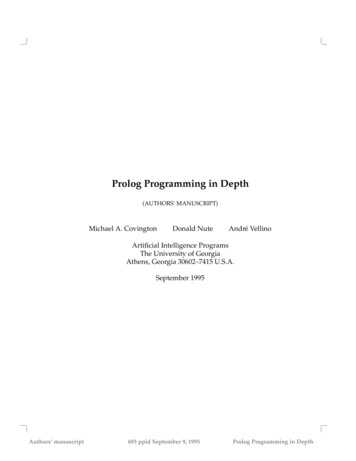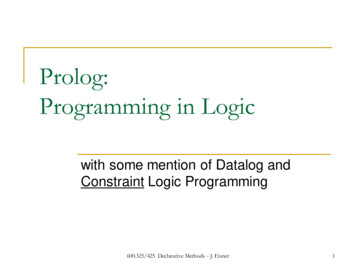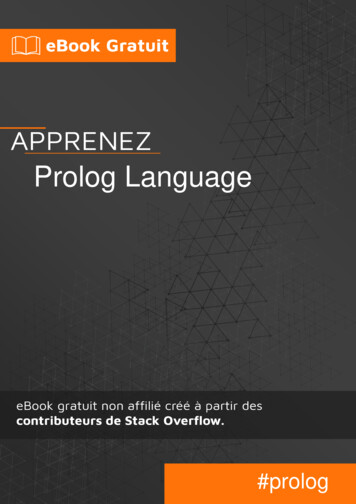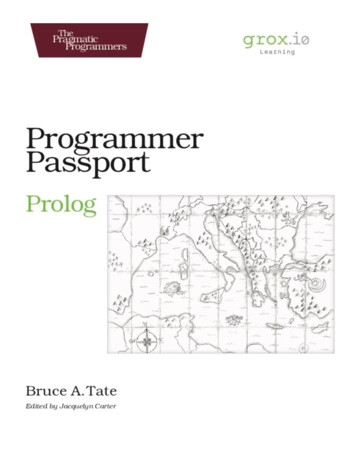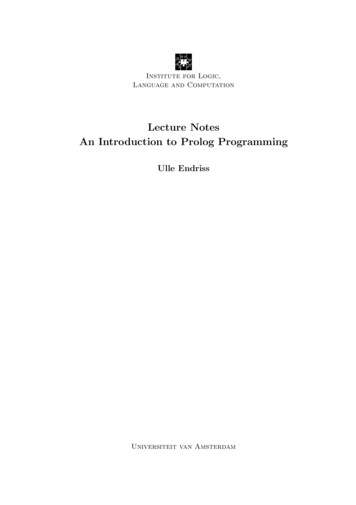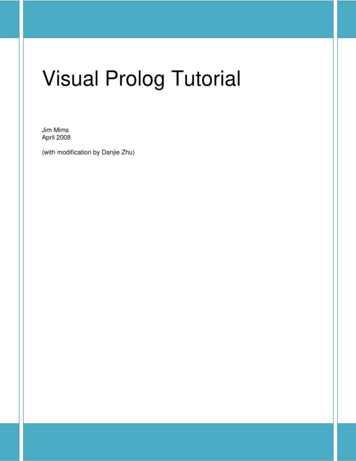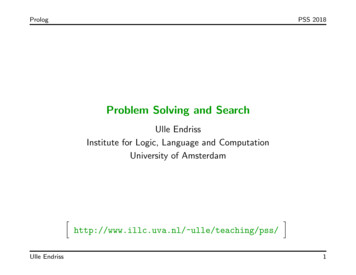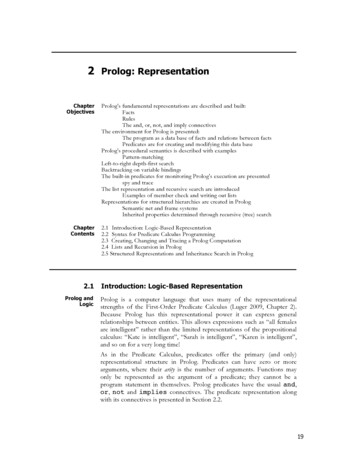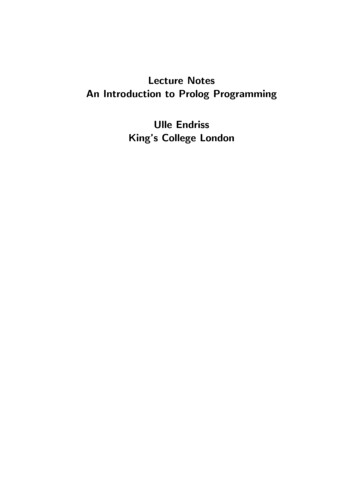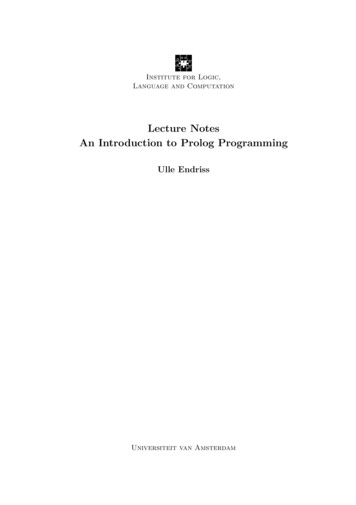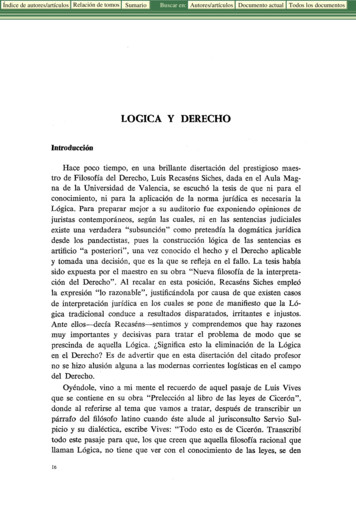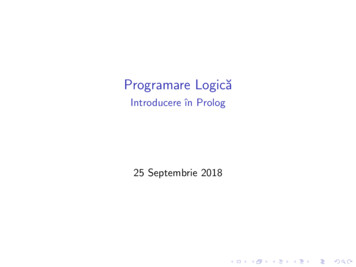
Transcription
Programare LogicăIntroducere ı̂n Prolog25 Septembrie 2018
Conţinutul cursuluiPart 1: Introducere ı̂n programarea logică şi programea ı̂nProlog. Bazată pe [Clocksin and Mellish, 2003].
Conţinutul cursuluiPart 1: Introducere ı̂n programarea logică şi programea ı̂nProlog. Bazată pe [Clocksin and Mellish, 2003].Part 2: O revizuire a bazei teoretice a programarii logice.Bazată pe [Ben-Ari, 2001] şi[Nilsson and Maluszynski, 2000].
Conţinutul cursuluiPart 1: Introducere ı̂n programarea logică şi programea ı̂nProlog. Bazată pe [Clocksin and Mellish, 2003].Part 2: O revizuire a bazei teoretice a programarii logice.Bazată pe [Ben-Ari, 2001] şi[Nilsson and Maluszynski, 2000].Part 3: Programare logică avansată. Bazată pe[Ben-Ari, 2001] şi [Nilsson and Maluszynski, 2000].
OrganizareIIIsabela DrămnescPagina web unde găsiţi cursurile:http://staff.fmi.uvt.ro/ isabela.dramnescIII14 Cursuri7 Laboratoare: PrologNotare:II50% : activitate curs şi laborator, teme50% : 1 examen scris (colocviu) (ı̂n ultimul curs)
Traditional programming paradigms
Recalling the Von Neumann machineIThe von Neumann machine (architecture) is characterized by:IIIA program for the von Neumann machine: a sequence ofinstructions forIIIIlarge uniform store of memory,processing unit with registers.moving data between memory and registers,carrying out arithmetical-logical operations between registers,control, etc.Most programming languages (like C, C , Java, etc.) areinfluenced by and were designed for the von Neumannarchitecture.IIIIIn fact, such programming languages take into account thearchitecture of the machine they address and can be used towrite efficient programs.The above point is by no means trivial, and it leads to aseparation of work (“the software crisis”):finding solutions of problems (using reasoning),implementation of the solutions (mundane and tedious).
Alternatives to the von Neumann approachIHow about making programming part of problem solving?Ii.e. write programs as you solve problems?I“rapid prototyping”?ILogic programming is derived from an abstract model (not areorganization/abstraction of a von Neumann machine).In logic programmingIIIprogram set of axioms,computation constructive proof of a goal statement.
Logic programming: some historyIDavid Hilbert’s program (early 20th century): formalize allmathematics using a finite, complete, consistent set of axioms.IKurt Gödel’s incompleteness theorem (1931): any theorycontaining arithmetic cannot prove its own consistency.IAlonzo Church and Alan Turing (independently, 1936):undecidability - no mechanical method to decide truth (ingeneral).
Logic programming: some historyIAlan Robinson (1965): the resolution method for first orderlogic (i.e. machine reasoning in first order logic).
Logic programming: some historyIAlan Robinson (1965): the resolution method for first orderlogic (i.e. machine reasoning in first order logic).IRobert Kowalski (1971): procedural interpretation of Hornclauses, i.e. computation in logic.
Logic programming: some historyIAlan Robinson (1965): the resolution method for first orderlogic (i.e. machine reasoning in first order logic).IRobert Kowalski (1971): procedural interpretation of Hornclauses, i.e. computation in logic.IAlan Colmerauer (1972): Prolog (PROgrammation enLOGique).prover.
Logic programming: some historyIAlan Robinson (1965): the resolution method for first orderlogic (i.e. machine reasoning in first order logic).IRobert Kowalski (1971): procedural interpretation of Hornclauses, i.e. computation in logic.IAlan Colmerauer (1972): Prolog (PROgrammation enLOGique).prover.IDavid H.D. Warren (mid-late 1970’s): efficientimplementation of Prolog.
Logic programming: some historyIAlan Robinson (1965): the resolution method for first orderlogic (i.e. machine reasoning in first order logic).IRobert Kowalski (1971): procedural interpretation of Hornclauses, i.e. computation in logic.IAlan Colmerauer (1972): Prolog (PROgrammation enLOGique).prover.IDavid H.D. Warren (mid-late 1970’s): efficientimplementation of Prolog.I1981 Japanese Fifth Generation Computer project: project tobuild the next generation computers with advanced AIcapabilities (using a concurrent Prolog as the programminglanguage).
Applications of logic programmingISymbolic computation:
Applications of logic programmingISymbolic computation:Irelational databases,
Applications of logic programmingISymbolic computation:IIrelational databases,mathematical logic,
Applications of logic programmingISymbolic computation:IIIrelational databases,mathematical logic,abstract problem solving,
Applications of logic programmingISymbolic computation:IIIIrelational databases,mathematical logic,abstract problem solving,natural language understanding,
Applications of logic programmingISymbolic computation:IIIIIrelational databases,mathematical logic,abstract problem solving,natural language understanding,symbolic equation solving,
Applications of logic programmingISymbolic computation:IIIIIIrelational databases,mathematical logic,abstract problem solving,natural language understanding,symbolic equation solving,design automation,
Applications of logic programmingISymbolic computation:IIIIIIIrelational databases,mathematical logic,abstract problem solving,natural language understanding,symbolic equation solving,design automation,artificial intelligence,
Applications of logic programmingISymbolic computation:IIIIIIIIrelational databases,mathematical logic,abstract problem solving,natural language understanding,symbolic equation solving,design automation,artificial intelligence,biochemical structure analysis, etc.
Aplications of logic programming (cont’d)IIndustrial applications:
Aplications of logic programming (cont’d)IIndustrial applications:Iaviation:
Aplications of logic programming (cont’d)IIndustrial applications:Iaviation:ISCORE - a longterm aiport capacity management system forcoordinated airports (20% of air traffic worldwide, accordingto www.pdc-aviation.com)
Aplications of logic programming (cont’d)IIndustrial applications:Iaviation:IISCORE - a longterm aiport capacity management system forcoordinated airports (20% of air traffic worldwide, accordingto www.pdc-aviation.com)FleetWatch - operational control, used by 21 international aircompanies.
Aplications of logic programming (cont’d)IIndustrial applications:Iaviation:IIISCORE - a longterm aiport capacity management system forcoordinated airports (20% of air traffic worldwide, accordingto www.pdc-aviation.com)FleetWatch - operational control, used by 21 international aircompanies.personnel planning: StaffPlan (airports in Barcelona, Madrid;Hovedstaden region in Denmark).
Aplications of logic programming (cont’d)IIndustrial applications:Iaviation:IIIISCORE - a longterm aiport capacity management system forcoordinated airports (20% of air traffic worldwide, accordingto www.pdc-aviation.com)FleetWatch - operational control, used by 21 international aircompanies.personnel planning: StaffPlan (airports in Barcelona, Madrid;Hovedstaden region in Denmark).information management for disasters: ARGOS - crisismanagement in CBRN (chemical, biological, radiological andnuclear) incidents – used by Australia, Brasil, Canada, Ireland,Denmark, Sweden, Norway, Poland, Estonia, Lithuania andMontenegro.
Rezolvarea problemelor folosind PrologIProgramarea ı̂n Prolog:IIIIı̂n loc de a scrie secvenţe de paşi pentru a rezolva o problemă,se descriu fapte şi relaţii cunoscute, apoi se pun ı̂ntrebări.Utilizare Prolog pentru a rezolva probleme care includ obiecteşi relaţii ı̂ntre obiecte.Exemple:IIIObiecte: “John”, “book”, “jewel”, etc.Relaţii: “John are o carte”, “Mariei ii place de Ion”.Reguli: “Două persoane sunt surori dacă amandouă sunt femeişi dacă au aceiaşi părinţi”.
Rezolvarea problemelor folosind PrologICum se rezolvă problemele ı̂n Prolog:IIIIse declară fapte despre obiecte şi relatiile dintre ele,se definesc reguli despre obiecte şi relaţiile dintre ele,se pun ı̂ntrebări despre obiecte şi relaţiile dintre ele.Programarea ı̂n Prolog: o conversaţie cu interpretorul Prolog.
FapteIScrierea unui fapt ı̂n Prolog:l i k e s ( j o h n n y , mary ) .IIIIIRelatiile (predicatele) şi obiectele se scriu cu litere mici.Prolog foloseste (mai mult) notatia prefix (dar exista siexceptii).Faptele se ı̂ncheie cu “.” (full stop).Un model este construit in Prolog, iar faptele descriu modelul.Utilizatorul trebuie să fie con ctient că următoarele:l i k e s ( j o h n , mary ) .l i k e s ( mary , j o h n ) .IIInu sunt identice.Putem avea un număr arbitrar de argumente.Notatie: likes /2 denotă un predicat binar.Faptele sunt parte a bazei de cunoştinţe Prolog (knowledgebase).
ÎntrebariIO intrebare in Prolog:? owns ( mary , book ) .IProlog cauta in baza de cunostinte fapte care fac matching(se potrivesc) cu ı̂ntrebarea:Prolog raspunde true daca :IIIpredicatele sunt la fel,argumentele sunt la fel,În caz contrat raspunsul este false :IIdoar ceea ce este cunoscut este true (“closed worldassumption”),Atenţie: false nu inseamna ca raspunsul este false (maidegraba “nu e dedus din baza de cunostinte”).
VariabileIGanditi-va la variabile in logica predicatelor.IIn loc de:? l i k e s ( j o h n , mary ) .? l i k e s ( j o h n , a p p l e s ) .? l i k e s ( j o h n , candy ) .intrebati ceva de genul “What does John like?” (vrem tot ceii place lui John).IIVariabilele sunt obiecte care urmeaza a fi determinate deProlog.Variabilele pot fi:IIIinstantiateneinstantiateIn Prolog variablele incep cu LITERE MARI:? l i k e s ( j o h n , X ) .
Exemplu in PrologISe considera urmatoarele fapte in baza de cunostinte Prolog:.l i k e s ( john , f l o w e r s ) .l i k e s ( j o h n , mary ) .l i k e s ( p a u l , mary ) .ILa intrebarea? l i k e s ( j o h n , X ) .Prolog va raspundeX flowerssi asteapta urmatoarele instructiuni.
Raspunsul PrologIProlog cauta in baza de cunostinte un fapt care potriveste cuintrebarea,
Raspunsul PrologIProlog cauta in baza de cunostinte un fapt care potriveste cuintrebarea,Icand o potrivire e gasita, aceasta se marcheaza.
Raspunsul PrologIProlog cauta in baza de cunostinte un fapt care potriveste cuintrebarea,Icand o potrivire e gasita, aceasta se marcheaza.Idaca utilizatorul apasa “Enter”, atunci cautarea se termina,
Raspunsul PrologIProlog cauta in baza de cunostinte un fapt care potriveste cuintrebarea,Icand o potrivire e gasita, aceasta se marcheaza.Idaca utilizatorul apasa “Enter”, atunci cautarea se termina,Idaca utilizatorul apasa “;” apoi “Enter”, Prolog cauta dupao noua potrivire, incepand din locul marcat, si cu variabileneinstantiate in intrebare.
Raspunsul PrologIProlog cauta in baza de cunostinte un fapt care potriveste cuintrebarea,Icand o potrivire e gasita, aceasta se marcheaza.Idaca utilizatorul apasa “Enter”, atunci cautarea se termina,Idaca utilizatorul apasa “;” apoi “Enter”, Prolog cauta dupao noua potrivire, incepand din locul marcat, si cu variabileneinstantiate in intrebare.IIn exemplul precedent, inca doua “; Enter” vor determinaProlog sa raspunda:X mary .false
Raspunsul PrologIProlog cauta in baza de cunostinte un fapt care potriveste cuintrebarea,Icand o potrivire e gasita, aceasta se marcheaza.Idaca utilizatorul apasa “Enter”, atunci cautarea se termina,Idaca utilizatorul apasa “;” apoi “Enter”, Prolog cauta dupao noua potrivire, incepand din locul marcat, si cu variabileneinstantiate in intrebare.IIn exemplul precedent, inca doua “; Enter” vor determinaProlog sa raspunda:X mary .falseICand nicio potrivire nu se mai gaseste in baza de cunostinte,Prolog raspunde false .
Conjunctii: intrebari mai complexeIConsideram urmatoarele fapte:likeslikeslikeslikes( mary ,( mary ,( john ,( john ,food ) .wine ) .wine ) .mary ) .
Conjunctii: intrebari mai complexeIConsideram urmatoarele fapte:likeslikeslikeslikesI( mary ,( mary ,( john ,( john ,food ) .wine ) .wine ) .mary ) .Si intrebarea:? l i k e s ( j o h n , mary ) , l i k e s ( mary , j o h n ) .
Conjunctii: intrebari mai complexeIConsideram urmatoarele fapte:likeslikeslikeslikesI( mary ,( mary ,( john ,( john ,food ) .wine ) .wine ) .mary ) .Si intrebarea:? l i k e s ( j o h n , mary ) , l i k e s ( mary , j o h n ) .Icitim “does john like mary and does mary like john?”
Conjunctii: intrebari mai complexeIConsideram urmatoarele fapte:likeslikeslikeslikesI( mary ,( mary ,( john ,( john ,food ) .wine ) .wine ) .mary ) .Si intrebarea:? l i k e s ( j o h n , mary ) , l i k e s ( mary , j o h n ) .IIcitim “does john like mary and does mary like john?”Prolog va raspunde false : cauta pentru fiecare goal (toategoal-urile trebuie sa fie satisfacute, iar daca nu, atunci nu vareusi, deci raspunsul va fi false ).
Conjunctii: intrebari mai complexeILa intrebarea:? l i k e s ( mary , X ) , l i k e s ( j o h n , X ) .
Conjunctii: intrebari mai complexeILa intrebarea:? l i k e s ( mary , X ) , l i k e s ( j o h n , X ) .IProlog: incearca sa satisfaca prima conditie (daca e satisfacuta,atunci marcheaza valoarea), apoi incearca sa satisfaca a douaconditie (daca e satisfacuta, atunci marcheaza valoarea).
Conjunctii: intrebari mai complexeILa intrebarea:? l i k e s ( mary , X ) , l i k e s ( j o h n , X ) .IIProlog: incearca sa satisfaca prima conditie (daca e satisfacuta,atunci marcheaza valoarea), apoi incearca sa satisfaca a douaconditie (daca e satisfacuta, atunci marcheaza valoarea).Daca intr-un punct esueaza, atunci se intoarce la ultimavaloare marcata si incearca alternative.
Exemple: conjunctiii, backtrackingModul in care Prolog calculeaza raspunsul la intrebarea urmatoareeste reprezentat astfel:I In Figura 1, prima conditie e satisfacuta, Prolog urmeaza sagaseasca o potrivire pentru a doua conditie (cu variabilainstantiata).I Daca esueaza sa gaseasca in baza de cunostinte o potrivireatunci incepe procesul de backtracking, in Figura 2.I Noua alternativa incercata reuseste pentru ambele conditii,vezi Figura 3.
Figure: Esecul pentru a doua conditie cauzeaza backtracking.
Figure: Success cu o alternativa instantiata.
ReguliI“John likes all people” se poate reprezenta:
ReguliI“John likes all people” se poate reprezenta:likeslikeslikeslikes.dar doar atat?!!!( john( john( john( john,,,,alfred ).bertrand ).charles ).david ) .
ReguliI“John likes all people” se poate reprezenta:likeslikeslikeslikes.( john( john( john( john,,,,alfred ).bertrand ).charles ).david ) .dar doar atat?!!!l i k e s ( john , X ) .dar ar trebui sa fie doar pentru oameni!!!
ReguliI“John likes all people” se poate reprezenta:likeslikeslikeslikes.( john( john( john( john,,,,alfred ).bertrand ).charles ).david ) .dar doar atat?!!!l i k e s ( john , X ) .dar ar trebui sa fie doar pentru oameni!!!IIntroducem reguli: “John likes any object, but only that whichis a person” este o regula despre ceva (cineva) pe care Johnplace.
ReguliI“John likes all people” se poate reprezenta:likeslikeslikeslikes.( john( john( john( john,,,,alfred ).bertrand ).charles ).david ) .dar doar atat?!!!l i k e s ( john , X ) .dar ar trebui sa fie doar pentru oameni!!!IIntroducem reguli: “John likes any object, but only that whichis a person” este o regula despre ceva (cineva) pe care Johnplace.IRegulile exprima: un fapt depinde de alt fapt.
Reguli ca definitiiIIRegulile pot fi folosite pentru a exprima “definitii”.Exemplu:“X is a bird if X is an animal and X has feathers.”IExemplu:“X is a sister of Y if X is female and X and Y have the sameparents.”IAtentie! Notiunea de “definitie” aici nu e aceeasi cu notiuneade definitie din logica:IIIIasemenea definitii permit detectarea predicatelor in capul uneireguli,dar pot fi si alte modalitati (ex. alte reguli cu acelasi cap)pentru a detecta asemenea predicate,pentru a avea o definitie completa ar trebui sa avem “iff” inloc de “if”.Regulile sunt afirmatii generale despre obiecte si relatiile dintreele (in general variabilele apar in reguli, dar nu intotdeauna).
Reguli in PrologIRegulile in Prolog au head si body.ICorpul (the body) unei reguli descrie conditiile ce trebuie safie satisfacute pentru ca head-ul sa fie true.IExemplu:l i k e s ( j o h n , X) : l i k e s (X , w i n e ) .l i k e s ( j o h n , X) : l i k e s (X , w i n e ) , l i k e s (X , f o o d ) .l i k e s ( j o h n , X) : f e m a l e (X ) , l i k e s (X , w i n e ) .IAtentie! Variabilele in reguli diferite sunt diferite.
Exemplu (royals)IBaza de cunoştinţe:male ( a l b e r t ) .male ( edward ) .female ( a l i c e ) .female ( v i c t o r i a ) .parents ( alice , albert ,p a r e n t s ( edward , a l b e r t ,s i s t e r o f (X , Y): f e m a l e (X ) ,p a r e n t s (X ,p a r e n t s (Y ,Ivictoria ).victoria ).M, F ) .M, F ) .Întrebări:? s i s t e r o f ( a l i c e , edward ) .? s i s t e r o f ( a l i c e , X ) .
Exerciţiu (thieves)ISe consideră următoarele:/ 1 / t h i e f ( j o h n ) ./ 2 / l i k e s ( mary , f o o d ) ./ 3 / l i k e s ( mary , w i n e ) ./ 4 / l i k e s ( j o h n , X): l i k e s (X , w i n e ) ./ 5 / m a y s t e a l (X , Y) : t h i e f (X ) , l i k e s (X , Y ) .IExplicaţi pentru ı̂ntrebarea următoare? m a y s t e a l ( j o h n , X ) .cum e executată ı̂n Prolog.
IIProlog programs are built from terms (written as strings ofcharacters).The following are terms:IIIconstants,variables,structures.
ConstantsIConstants are simple (basic) terms.IThey name specific things or predicates (no functions inProlog).Constants are of 2 types:IIIatoms,numbers: integers, rationals (with special libraries), reals(floating point representation).
Examples of atomsIatoms:IIIIIIIlikes ,a (lowercase letters), , ,’Void’ (anything between single quotes),george smith (constants may contain underscore),not atoms:IIII314a5 (cannot start with a number),george smith (cannot contain a hyphen),George (cannot start with a capital letter),something (cannot start with underscore).
VariablesIVariables are simple (basic) terms,Iwritten in uppercase or starting with underscore ,IExamples: X, Input, something,anonymous variable).IAnonymous variables need not have consistent interpretations(they need not be bound to the same value):(the last one called? l i k e s ( , j o h n ) . % d o e s anybody l i k e John ?% d o e s anybody l i k e anybody ? l i k e s ( , ) .
StructuresIStructure are compound terms, single objects consisting ofcollections of objects (terms),Ithey are used to organize the data.IA structure is specified by its functor (name) and itscomponentsowns ( john , book ( w u t h e r i n g h e i g h t s , b r o n t e ) ) .book ( w u t h e r i n g h e i g h t s , a u t h o r ( e m i l y , b r o n t e ) ) .? owns ( john , book (X , a u t h o r (Y , b r o n t e ) ) ) .% d o e s John own a book (X) by B r o n t e (Y , b r o n t e ) ?
Characters in PrologICharacters:IIIIIA-Za-z0-9 -*/\? @# & ˆ : .ICharacters are ASCII (printing) characters with codes greaterthan 32.IRemark: ’ ’ allows the use of any character.
Arithmetic operatorsIArithmetic operators:IIII , , ,/,I (x, (y , z)) is equivalent with x (y · z)IOperators do not cause evaluation in Prolog.IExample: 3 4 (structure) does not have the same meaningwith 7 (term).IX is 3 4 causes evaluation ( is represents the evaluator inProlog).IThe result of the evaluation is that X is assigned the value 7.
Parsing arithmetic expressionsITo parse an arithmetic expression you need to know:IThe position:IIIIIinfix: x y , x yprefix xpostfix x!Precedence: x y z ?Associativity: What is x y z? x (y z) or (x y ) z?
IEach operator has a precedence class:IIIIII / have higher precedence than 8/2/2 evaluates to:III1 - highest2 - lower.lowest8 (8/(2/2)) - right associative?or 2 ((8/2)/2) - left associative?Arithmetic operators are left associative.
The unification predicate ’ ’I - infix built-in predicate.? X Y .Prolog will try to match(unify) X and Y, and will answer trueif successful.IIn general, we try to unify 2 terms (which can be any ofconstants, variables, structures):? T1 T2 .IRemark on terminology: while in some Prolog sources theterm “matching” is used, note that in the (logic) literaturematching is used for the situation where one of the terms isground (i.e. contains no variables). What does isunification.
The unification procedureSummary of the unification procedure ? T1 T2:IIf T1 and T2 are identical constants, success (Prolog answerstrue);IIf T1 and T2 are uninstantiated variable, success (variablerenaming);IIf T1 is an uninstantiated variable and T2 is a constant or astructure, success, and T1 is instantiated with T2;IIf T1 and T2 are instantiated variables, then decide accordingto their value (they unify - if they have the same value,otherwise not);IIf T1 is a structure: f (X1 , X2 , ., Xn ) and T2 has the samefunctor (name): f (Y1 , Y2 , ., Yn ) and the same number ofarguments, then unify these arguments recursively (X1 Y1 ,X2 Y2 , etc.). If all the arguments unify, then the answer istrue, otherwise the answer is false (unification fails);IIn any other case, unification fails.
Occurs checkIConsider the following unification problem:? X f (X ) .
Occurs checkIConsider the following unification problem:? X f (X ) .IAnswer of Prolog:X f ( ).
Occurs checkIConsider the following unification problem:? X f (X ) .IAnswer of Prolog:X f ( ).X f (X ) .
Occurs checkIConsider the following unification problem:? X f (X ) .IAnswer of Prolog:X f ( ).X f (X ) .IIn fact this is due to the fact that according to the unificationprocedure, the result isX f(X) f(f(X)) . f ( f (.( f (X ).))) - an infiniteloop would be generated.
IUnification should fail in such situations.ITo avoid them, perform an occurs check: If T1 is a variableand T2 a structure, in an expression like T1 T2 make surethat T1 does not occur in T2.IOccurrence check is deactivated by default in most Prologimplementations (is computationally very expensive) - Prologtrades correctness for speed.A predicate complementary to unification:III\ succeeds only when fails,i.e. T1 \ T2 cannot be unified.
Built-in predicates for arithmeticIIProlog has built-in numbers.Built-in predicates on numbers include:XXXXXX Y,\ Y, Y, Y, Y, Y,with the expected behaviour.INote that variables have to be instantiated in most cases(with the exception of the first two above, where unification isperformed in the case of uninstantiation).
The arithmetic evaluator isIProlog also provides arithmetic operators (functions), e.g.: , , , /, mod, rem, abs, max, min, random, floor , ceilingetc, but these cannot be used directly for computation(2 3means 2 3, not 5) - expressions involving operators are notevaluated by default.IThe Prolog evaluator is has the form:X i s Expr .where X is an uninstantiated variable, and Expr is anarithmetic expression, where all variables must be instantiated(Prolog has no equation solver).
Example (with arithmetic(1))r e i g n s ( r h o n d r i , 844 , 8 7 8 ) .r e i g n s ( anarawd , 8 7 8 , 9 1 6 ) .r e i g n s ( hywel dda , 916 , 9 5 0 ) .r e i g n s ( l a g o a p i d w a l , 950 , 9 7 9 ) .r e i g n s ( h y w e l a p i e u a f , 979 , 9 8 5 ) .r e i g n s ( cadwallon , 985 , 9 8 6 ) .r e i g n s ( maredudd , 9 8 6 , 9 9 9 ) .p r i n c e (X , Y): r e i g n s (X , A , B ) ,Y A ,Y B .? p r i n c e ( c a d w a l l o n , 9 8 6 ) .true? p r i n c e (X , 9 7 9 ) .X lago ap idwal ;X hywel ap ieuaf
Example (with arithmetic(2))pop ( p l a c e 1pop ( p l a c e 2pop ( p l a c e 3pop ( p l a c e 4,,,,203).548).800).108).area ( place1 , 3) .area ( place2 , 1) .area ( place3 , 4) .area ( place4 , 3) .d e n s i t y (X , Y): pop (X , P ) ,a r e a (X , A ) ,Y i s P/A .? d e n s i t y ( p l a c e 3 , X ) .X 200true
IIn this lecture the following were discussed:IIIIIIIIIasserting facts about objects,asking questions about facts,using variables, scopes of variables,conjunctions,an introduction to backtracking (in examples),Prolog syntax: terms (constants, variables, structures),Arithmetic in Prolog,Unification procedure,Subtle point: occurs check.
IAll things SWIProlog can be found athttp://www.swi-prolog.org.IInstall SWI-Prolog and try out the examples in the lecture.IRead: Chapter 1 and Chapter 2 (including exercises section)of [Clocksin and Mellish, 2003].
Ben-Ari, M. (2001).Mathematical Logic for Computer Science.Springer Verlag, London, 2nd edition.Clocksin, W. F. and Mellish, C. S. (2003).Programming in Prolog.Springer, Berlin, 5th edition.Nilsson, U. and Maluszynski, J. (2000).Logic, Programming and Prolog.copyright Ulf Nilsson and Jan Maluszynski, 2nd edition.
Rezolvarea problemelor folosind Prolog I Programarea n Prolog: I n loc de a scrie secvent e de pa si pentru a rezolva o problem a, I se descriu fapte si relat ii cunoscute, apoi se pun ntreb ari. I Utilizare Prolog pentru a rezolva probleme care includobiecte sirelat ii ntre obiecte. I Exemple: I Obiecte: \John", \book", \jewel .
